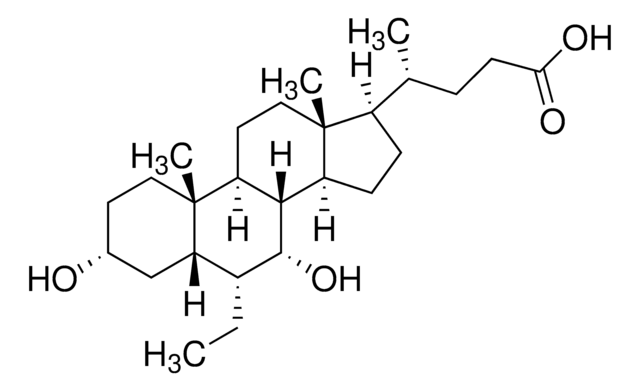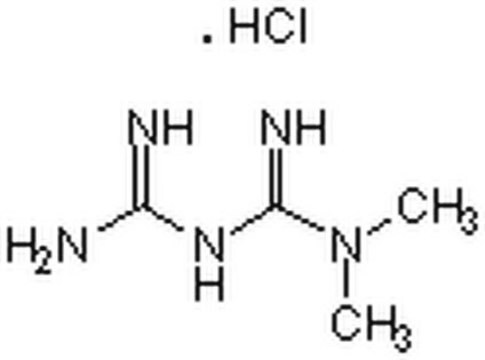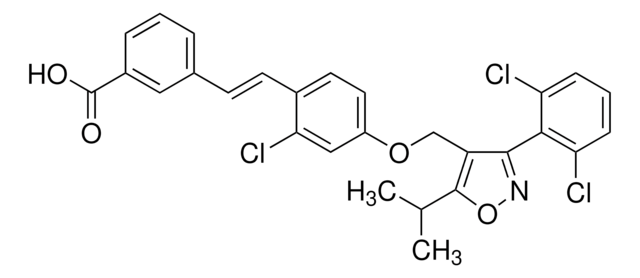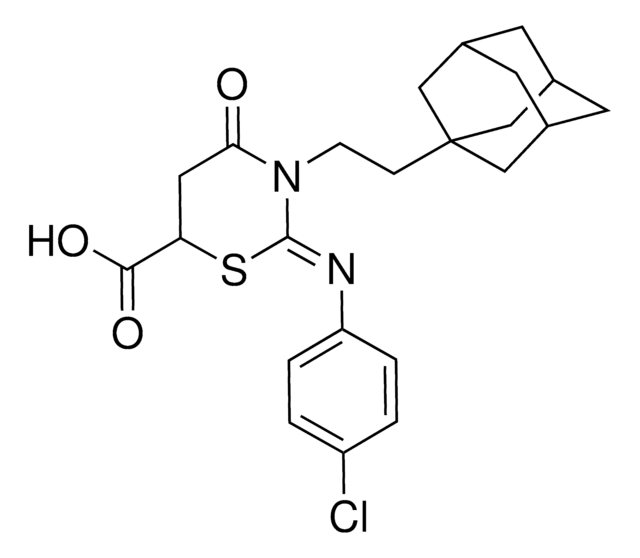SML1390
Fexaramine
≥98% (HPLC)
동의어(들):
3-[3-[(Cyclohexylcarbonyl)[[4′-(dimethylamino)[1,1′-biphenyl]-4-yl]methyl]amino]phenyl]-2-propenoic acid methyl ester
로그인조직 및 계약 가격 보기
모든 사진(1)
About This Item
실험식(Hill 표기법):
C32H36N2O3
CAS Number:
Molecular Weight:
496.64
MDL number:
UNSPSC 코드:
12352116
PubChem Substance ID:
NACRES:
NA.77
추천 제품
Quality Level
분석
≥98% (HPLC)
형태
powder
저장 조건
desiccated
색상
white to beige
solubility
DMSO: 10 mg/mL, clear
저장 온도
2-8°C
SMILES string
CN(C)C(C=C1)=CC=C1C2=CC=C(CN(C3=CC=CC(/C=C/C(OC)=O)=C3)C(C4CCCCC4)=O)C=C2
InChI
1S/C32H36N2O3/c1-33(2)29-19-17-27(18-20-29)26-15-12-25(13-16-26)23-34(32(36)28-9-5-4-6-10-28)30-11-7-8-24(22-30)14-21-31(35)37-3/h7-8,11-22,28H,4-6,9-10,23H2,1-3H3/b21-14+
InChI key
VLQTUNDJHLEFEQ-KGENOOAVSA-N
일반 설명
Fexaramine belongs to the nuclear hormone receptor family.
애플리케이션
Fexaramine has been used to study its action on RANKL (receptor activator of nuclear factor-κB ligand)-induced osteoclastogenesis in mouse model.
생화학적/생리학적 작용
Fexaramine is a potent and selective agonist of the bile acid sensor farnesoid X receptor (FXR) in the gut with an EC50 of 25 nM and no activity found for other nuclear receptors. Fexaramine induces enteric fibroblast growth factor 15 (FGF15), causing alterations in bile acid composition without activating FXR target genes in the liver. In mouse studies, fexaramine enhanced thermogenesis and browning of white adipose tissue while reducing diet-induced weight gain, body-wide inflammation and hepatic glucose production. Fexaramine also improved insulin responsiveness.
Fexaramine might regulate lipid and glucose metabolism and can serve as a therapeutic target in the treatment of fatty liver disease, type 2 diabetes and obesity. Fexaramine might mediate cholesterol homeostasis and promotes osteoblast differentiation and suppresses differentiation of osteoclast.
신호어
Warning
유해 및 위험 성명서
예방조치 성명서
Hazard Classifications
Acute Tox. 4 Oral - Aquatic Chronic 4
Storage Class Code
11 - Combustible Solids
WGK
WGK 3
Flash Point (°F)
Not applicable
Flash Point (°C)
Not applicable
시험 성적서(COA)
제품의 로트/배치 번호를 입력하여 시험 성적서(COA)을 검색하십시오. 로트 및 배치 번호는 제품 라벨에 있는 ‘로트’ 또는 ‘배치’라는 용어 뒤에서 찾을 수 있습니다.
Farnesoid X receptor modulators (2011?2014): a patent review.
Sepe V, et al.
Expert Opinion on Therapeutic Patents, 25(8), 885-896 (2015)
Fexaramine Inhibits Receptor Activator of Nuclear Factor-?B Ligand-induced Osteoclast Formation via Nuclear Factor of Activated T Cells Signaling Pathways.
Zheng T, et al.
Journal of bone metabolism, 24(4), 207-215 (2017)
자사의 과학자팀은 생명 과학, 재료 과학, 화학 합성, 크로마토그래피, 분석 및 기타 많은 영역을 포함한 모든 과학 분야에 경험이 있습니다..
고객지원팀으로 연락바랍니다.









